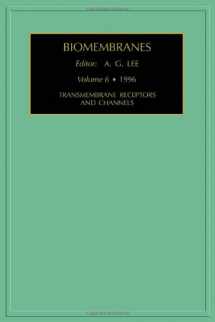
Transmembrane Receptors and Channels (Volume 6) (Biomembranes. A Multi-Volume Treatise, Volume 6)
ISBN-13:
9781559386630
ISBN-10:
1559386630
Edition:
1
Author:
A.G. Lee
Publication date:
1997
Publisher:
Elsevier Science
Format:
Hardcover
420 pages
FREE US shipping
on ALL non-marketplace orders
Marketplace
from $58.53
USD
Marketplace offers
Seller
Condition
Note
Seller
Condition
Used - Very Good
Book details
ISBN-13:
9781559386630
ISBN-10:
1559386630
Edition:
1
Author:
A.G. Lee
Publication date:
1997
Publisher:
Elsevier Science
Format:
Hardcover
420 pages
Summary
Transmembrane Receptors and Channels (Volume 6) (Biomembranes. A Multi-Volume Treatise, Volume 6) (ISBN-13: 9781559386630 and ISBN-10: 1559386630), written by authors
A.G. Lee, was published by Elsevier Science in 1997.
With an overall rating of 3.9 stars, it's a notable title among other
books. You can easily purchase or rent Transmembrane Receptors and Channels (Volume 6) (Biomembranes. A Multi-Volume Treatise, Volume 6) (Hardcover) from BooksRun,
along with many other new and used
books
and textbooks.
And, if you're looking to sell your copy, our current buyback offer is $0.3.
Description
Volume 6 of Biomembranes covers transmembrane receptors and channels. A particularly important role for the membrane is that of passing messages between a cell and its environment. Part I of this volume covers receptors for hormones and growth factors. Here, as in so many other areas of cell biology, the application of the methods of molecular biology have led to the recognition of a number of families of receptors. Typically, such receptors contain an extracellular ligand binding domain, a transmembrane domain, and an intracellular catalytic domain whose activation, as a result of ligand binding, leads to generation of second messengers within the cell and stimulation of a range of cytosolic enzymes. An alternative signaling strategy, exploited in particular in the nervous system, is to use ion channels to allow controlled movement of monovalent (Na+, K+) or divalent (Ca2+) cations in or out of the cell, resulting in changes in membrane potential or alterations in the intracellular concentration of Ca2+. Part II of this volume is concerned with these ion channels and with other, often simpler, ion channel systems whose study can throw light on channel mechanism.


We would LOVE it if you could help us and other readers by reviewing the book
Book review

Congratulations! We have received your book review.
{user}
{createdAt}
by {truncated_author}


